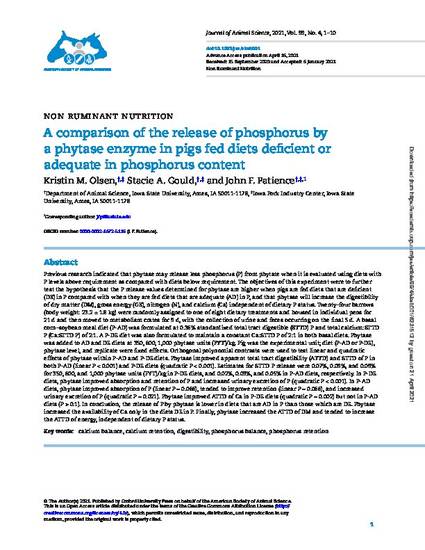
Previous research indicated that phytase may release less phosphorus (P) from phytate when it is evaluated using diets with P levels above requirement as compared with diets below requirement. The objectives of this experiment were to further test the hypothesis that the P release values determined for phytase are higher when pigs are fed diets that are deficient (DE) in P compared with when they are fed diets that are adequate (AD) in P, and that phytase will increase the digestibility of dry matter (DM), gross energy (GE), nitrogen (N), and calcium (Ca) independent of dietary P status. Twenty-four barrows (body weight: 23.2 ± 1.8 kg) were randomly assigned to one of eight dietary treatments and housed in individual pens for 21 d and then moved to metabolism crates for 9 d, with the collection of urine and feces occurring on the final 5 d. A basal corn–soybean meal diet (P-AD) was formulated at 0.36% standardized total tract digestible (STTD) P and total calcium:STTD P (Ca:STTD P) of 2:1. A P-DE diet was also formulated to maintain a constant Ca:STTD P of 2:1 in both basal diets. Phytase was added to AD and DE diets at 350, 600, 1,000 phytase units (FYT)/kg. Pig was the experimental unit; diet (P-AD or P-DE), phytase level, and replicate were fixed effects. Orthogonal polynomial contrasts were used to test linear and quadratic effects of phytase within P-AD and P-DE diets. Phytase improved apparent total tract digestibility (ATTD) and STTD of P in both P-AD (linear P < 0.001) and P-DE diets (quadratic P < 0.001). Estimates for STTD P release were 0.07%, 0.09%, and 0.09% for 350, 600, and 1,000 phytase units (FYT)/kg in P-DE diets, and 0.02%, 0.03%, and 0.05% in P-AD diets, respectively. In P-DE diets, phytase improved absorption and retention of P and increased urinary excretion of P (quadratic P < 0.001). In P-AD diets, phytase improved absorption of P (linear P = 0.066), tended to improve retention (linear P = 0.066), and increased urinary excretion of P (quadratic P = 0.021). Phytase improved ATTD of Ca in P-DE diets (quadratic P = 0.002) but not in P-AD diets (P > 0.1). In conclusion, the release of P by phytase is lower in diets that are AD in P than those which are DE. Phytase increased the availability of Ca only in the diets DE in P. Finally, phytase increased the ATTD of DM and tended to increase the ATTD of energy, independent of dietary P status.
Available at: http://works.bepress.com/john-patience/165/

This article is published as Olsen, Kristin M., Stacie A. Gould, and John F. Patience. "A comparison of the release of phosphorus by a phytase enzyme in pigs fed diets deficient or adequate in phosphorus content." Journal of Animal Science 99, no. 4 (2021): skab001. doi:10.1093/jas/skab001.